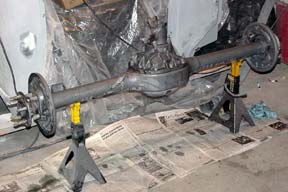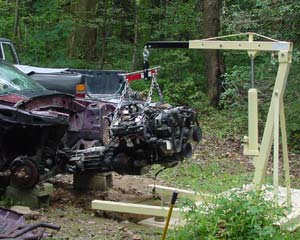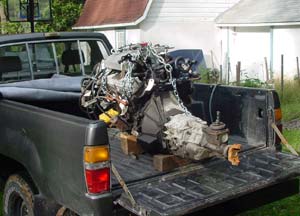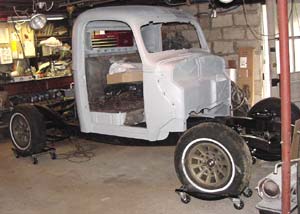March-April 2003 I finally found a rear end! It is a Ford 8-inch rear with
drum brakes from a 1977 Granada.
The gear ratio is only 2.79, so I plan on getting terrific gas mileage. I dismantled the brakes, blasted
the axle, and put on two coats of Zero Rust. I purchased a Chassis Engineering parallel leaf
rear spring kit. According to the salesman, the Granada rear should bolt right in -- no need to
move or replace the spring perches. While the ole credit card was smokin' I also bought a Heidt's
Mustang II independent front suspension kit. Now all I have to do is install all this stuff...

I think I sanded all the parts I sprayed with 2K primer last summer. Every time I look somewhere, I see another part hanging or stashed that needs to be sanded.
May to July 2003 Much of June and July was taken up by preparing
for the 2003 road trip, driving
10,000 miles on the road trip, and recovering from the road trip.
I fitted and tack-welded the new Mustang II cross-member to the frame. I planned on having a mobile
welder come to my garage and do the finish welding. A few
months ago I copied down the name and phone number of a mobile welder
specializing in automotive welding from the bulletin board at Eastwood.
When I called him, he said he no longer did mobile welding because the
insurance cost him more than he was making. OK. I then let my fingers do
the walking through the yellow pages where three companies that did
mobile welding were listed. Three phone calls yielded three disconnected numbers. Next
I called and talked to several local welders about what I needed done and the
logistics of dropping off a truck frame at their shop. A couple of weeks
later, I loaded the frame into the Toyota and dropped it off. I picked it
up later the same day. I am very pleased with the welding job.
Since it was looking like I might actually have the frame rolling on some
wheels this year, It was time to start thinking again about finding an engine.
I gave up on the idea of a Mustang 4.6 liter motor. The only way to bypass the Ford PATS
system is with a $1,500 wiring harness. Then there is the $400+ rear sump oil pan.
My new imagined scenario was to buy a wrecked Mustang GT and pull out the 5.0
liter HO fuel injected engine with all the necessary wiring and components
and the 5 speed. My experience is limited to carbureted engines with
simple or no emissions equipment and no computer. I did not want to buy a
junkyard engine with wires, hoses, and parts hanging, cut, and missing
because I knew I would never figure out the wiring and emissions enough to
get the engine to run. I made a lot of phone calls. Salvage yards won't
sell a wrecked car. Insurance companies won't sell a wrecked car. To get
into the auctions that sell wrecked cars, you have to be licensed. I could
buy a "rebuildable" but the minimum price was about 4 or 5 thousand bucks,
far too high for an engine. I did locate a guy about 2+ hours away that bought
wrecked Mustangs and parted them out who was willing to sell me a complete
engine and transmission. Hopefully I could locate someone closer to my house
that did the same thing.
One day I went to West Chester to meet with the EPA and the Chester County Health
Department about some of the local Superfund sites. The route home
took me past Mid-County Mustang, which specializes in the restoration of
1960's and early 1970's Mustangs. I knew that they would not be able to
help me out with a newer engine, but maybe they knew of someone locally
that could. I often run into parts guys with the most amazing connections.
I stopped in and explained what I was looking for. The gentleman behind the
counter said he couldn't help me out, but Ray was the guy I needed to talk
to. He punched up Rays number and handed the phone to me. I explained to
Ray what I was looking for. Ray said "I have just what you are looking for.
It came in yesterday. Come over and take a look." It turns out that Ray
owns Performance Specialties (they advertise in the Mustang and 5.0
magazines) and is only about 7 miles from my house.
A few hours later I paid Ray a visit. He has a nice shop with a dynometer.
It was full of Cobras and corvettes. The garage floor was so clean you
could eat off it. One of his customers had an 88 GT that he wrecked over
the weekend. It was behind the shop. Ray was planning to part it out, the
first car he was parting out in over two years. It had 72,000 miles on the
odometer and had a new clutch, big throttle body, and headers. I told Ray
that I wanted the complete engine with all the wiring harnesses,
components, accessories, computer, etc. and the 5 speed. We agreed on a
price for the engine and transmission plus a price for him to pull
everything and deliver it to my door. It even came with a warranty that
goes into effect when my '38 hits the road.
A couple of days later Ray called and asked if I would be interested in
buying the stripped car (minus the interior, pedals, wheels, rear axle,
good door, trim, lights, etc. etc.) with the engine and transmission in it. It
would save me the cost of paying him to pull the engine. After calling my
local towing guy [side note: when this guy has to tow my dead Toyota, my wife
offers him money to let it slip off the tow truck and roll down the hill into
French Creek] and confirming that he would pick up and deliver a car
with no front wheels or rear axle, I agreed to buy the remains of the deceased GT.
A couple of days later, the GT was delivered. That was a bit of a disaster.
I wanted it dropped in the woods where I could hide it until I pulled the
engine. We had a very very wet spring, and everything was mud or standing water
at the time of the delivery.
Parke got the rollback as far in as he could (which was not very far) and then
got stuck in the mud. The Mustang was dropped as far as you can get a car
with no wheels from a tow truck stuck in the mud. A second truck had to
come to winch out the rollback. I covered the GT with a camouflage tarp, threw some
grass seed in the ruts, and
went on my vacation the next day.
I wasn't expecting to find an engine so fast and certainly not one with the
car still attached. It was amazing how fast this all fell together. I
always wanted a Mustang GT, but this one isn't quite what I envisioned.
We had 14 inches of rain in September (usual is around 4 inches) so the woods were somewhere
between a bog and a mud pit. But
I was prepared. I put a sheet of 3/4 -inch plywood under the back wheels of the engine hoist so it would roll.
Unfortunately, the front wheels were under the car, and they sunk into the mud. Moving the engine became
a long process of lowering it, pulling the hoist back, raising it and letting it move a few inches forward,
then lowering and repeating the process. This was not going according to plan but eventually I got the
engine out, away from the car, and swung around. I backed the Toyota under the engine. Oops. I backed up
a little too far and bumped the hoist. What happened next was like watching one of those slow motion movie
scenes. The hoist tipped over, the engine swung over to the other side of the Mustang and hit the ground. There was
nothing I could do but watch. The fall of the engine was broken by the engine hoist getting jammed up under my
rear bumper. It made a gentle landing in some very soft moss-covered ground. I had to extricate the engine
hoist from beneath the Toyota, which was not easy to do. I did not recall this being part of the plan.
However, the engine landed in a much better position for loading into the Toyota. After setting up again and hoisting
the engine into the air, I very very carefully backed the Toyota under the engine and then lowered it into the bed.
![]()

![]() THE POWER OF PLASTIC --
THE POWER OF PLASTIC --
I CHARGED THIS ON MY VISA!!!
August & September 2003 Work on the '38 truck project consisted of
dismantling the Mustang.
Before I could remove the engine, I had to disconnect the 2,000 wires, hoses,
brackets, lines, and assorted gizmos. I bought 200 wire-tie tags that I attached to each end
of each disconnected wire, hose, and plug so I would know what connected to what when
I install the engine in the '38. I also used the tags on the wiring harnesses when I
disconnected them. I used about 140 tags!
I removed all the wiring from the Mustang. I plan to use the fuse panel and as much of
the wiring as possible. One harness (EFI harness) consisted of the computer and attached
wiring that runs to the engine. The computer was located where the car got hit, and the case was
bent. I opened it up, and everything inside looked fine; there is no apparent damage to the
circuit board. I hope.
The other engine harness connected the starter relay,
alternator, coil, front lights, etc. to the dashboard harness. The instruments and switches already
had been removed, so the dash harness had a lot of plugs and loose wires that used to
connect somewhere. A good wiring diagram will help me straighten that out. Last to be
removed was the harness
that ran to the back of the car and connected the rear lights, fuel tank, inertia switch, etc.
The wiring filled four large cardboard boxes!
If I bought just an engine, it would have been a daunting task for me to figure out
what connected to what and what was missing. I have everything complete and hopefully will be
able to connect everything back up. It also provided other minor (maybe not so minor)
items I need, like the computer, starter relay, coil, cruise control, etc.
I also salvaged the master cylinder and booster. The Mustang uses a
10.84-inch front disk brake and rear drum brakes. My '38 will have an 11-inch disk up front and
drum brakes in the rear. About a perfect match!
To make it easier to pull the engine out, I removed the mangled radiator, AC condenser, and
headers. I
had to cut the sheet metal that ran across the front of the engine compartment to remove the
radiator. Many other components also had to be disconnected --
power steering hoses, fuel lines, emissions stuff, etc. Everything is disconnected. the engine
is ready to come out. All I need is a place to put the engine!
October & November 2003 I wanted to get the engine out of the Mustang
and indoors before the weather
turned bad. That was my first order of business.
To get at the motor mount bolts and facilitate
getting the engine out, I cut off the front of the car from the springs forward. It took almost
5 minutes with the sawz-all. Then I devised a plan. I would pull the engine out, swing it around, hoist it up, back
the Toyota under it, and drop it in the bed of the Toyota. I would back the Toyota into the garage,
hoist the engine out, and put it somewhere. As usual, easier said than done. I used the header bolts to
bolt the engine hoist to the heads. I removed the motor mount bolts and the engine was free.

I set up the engine hoist in the garage and drove the Toyota into the garage. I chained up the engine and began
lifting it. Thunk. There was that low ceiling and the hoist hitting it. This wasn't in the plan either.
I moved the Toyota out of the garage and pulled
the engine out out of the bed. Then it was a process of lowering the engine to the ground, pulling the hoist back
on the dirt driveway,
raising the engine, letting it swing back a few inches, lowering the engine, pulling the hoist back, you get the
picture, until the engine was safely in the garage and out of the weather.

More good news. The frame is now a chassis! For the rear suspension, I installed a
Chassis Engineering, Inc.
bolt-in parallel leaf spring kit (P/N AS-2016CF). It was not quite "bolt-in."
The instructions began with "remove 3 rivets from each side."
The bolt-in required about 20 hours of drilling out rivets and drilling mounting holes through the frame
(usually 2 or 3 layers of metal thick). Everything fit well, and the rear axle bolted right in.
I added a temporary pair of 15-inch wheels and tires procured from a 1988 Thunderbird in the junkyard.
When I bought the Heigt's Mustang II front end kit, the salesman at the rod shop convinced me
to substitute different upper
control arms because they were "stronger and less expensive than the ones supplied by Heidt's." Those were the ones
his shop has used for years. It turned out that he substituted everything; nothing but the cross-member
came from Heidt's. So now I had a big pile of boxes of parts and no instructions on how to assemble
those parts into a front suspension system. I called the rod shop and asked for assembly instructions. He told me
"there were no instructions and I didn't need instructions because everyboby knows how to put them together." I told
him I never put one of these together, didn't know how, and needed some instructions. He told me it was
easy, just remember to put the bolts up from the bottom. Needless to say, my feet will never enter that
shop again.
Time for research. A trip to the County library netted some old Chilton late 70's - early 80's
Ford manuals with exploded view
diagrams that were close enough. A search of the web turned up an article --
Hot Rod Magazine's
1939 Ford Project: Front Suspension.
That was all I needed to assemble the front suspension.
Best of all, I had no left over parts when I was done! I put the other pair of Thunderbird wheels on,
and was now the proud
owner of a "rolling chassis." I had the cab in one bay of the garage and the rolling chassis in the other bay.

With cold weather upon us (and the potential for dredded frost on my wife's windshield),
I had to free up one bay of the garage so my wife could park her Jeep inside.
The only way to do that was to mount the cab back on the chassis. In doing so, I had to get the wood and
rubber mounting pads exactly where they belonged between the cab and frame. I devised yet another plan. I would hoist
the cab and tie it to ceiling, slide the chassis under the cab, and lower the cab onto the chassis. Once
again, easier said than done. First I put
the chassis on car dollies so that I could maneuver it sideways and push it anywhere I wanted. The
down side to this is that it raised the chassis a few inches in a garage with a very low ceiling. To get
the cab high enough, it would have to be touching the ceiling. By jacking and blocking and jacking and blocking
and jacking and blocking, etc., I got the cab to the ceiling. I ran some webbing through the front and back windows
and secured the cab to the ceiling. I then removed the blocks and jacks. It sagged too low to get the chassis
underneath. It was also too far back. I got the cab back down to earth and moved it forward one rafter. Then
by jacking and blocking and jacking and blocking
and jacking and blocking, etc., I got the cab back up to the ceiling. This time I ran some 3/4-inch rope
through the front and back windows and secured the cab to the ceiling. I removed the blocks and jacks.
Again, it sagged too low to get the chassis underneath. Once more, I moved it back up to the ceiling by jacking
and blocking, etc. etc. etc. I removed the rope and attached chains. Chain don't sag.
I positioned the chassis under the cab
and positioned the cab to frame wood. I used the original wood. It was in excellent shape, except for
the back ends which were a bit rotted, but it was 94% intact, so good enough. (They do make replacement wood. It
is available from many of the repro vendors on the
LINKS PAGE).
I put the rubber mounting pads
( Wescott's Auto Restyling P/N A-5000-P)
in place and put the bolts through.
(Roy Nacewicz Enterprises P/N T-94-06)
No web site -- Roy Nacewicz Enterprises, PO Box 544, Carleton, MI 48117, PH: 734-654-9450, FAX: 734-654-9530.
Has over 3,000 hardware offerings in kit form in correct Ford finishes, catalog $3, ggod stuff,
stuff you can't buy any where else.)
I slowly lowered the
cab making sure everything was lined up properly. I tightened up the bolts (but not too tight) and did not
put the cotter pins in the castle nuts in case I need to "adjust" the cab slightly to get the hood and fenders
to line up properly some day.

December 2003
December was "Parts Fetching Month." I did the junkyard tour -- five U-pull-it junkyards in 2 days. And then
I re-visited 4 of them again.
My goal was to find a GM T-5 transmission and a Ford steering column plus some other odds and ends.
First the transmission. A quick trial fitting of the Mustang engine and transmission put the shifter
right up against the seat. I had read/heard that the T-5 tailhousing from a 1980's Chevy S-10, Blazer,
or GMC S-15 2WD is interchangeable with the Mustang T-5 and moves the shifter forward about 10 inches.
In five junkyards I found only two transmissions, both in the same yard. I pulled the better one out of a GMC. I almost
had it out when they called quitting time, and I had to leave. I came back the next morning and finished
getting it out. I pulled apart the Mustang transmission and swapped the necessary parts on top. Then I slid on
the GM tailhousing. It did not fit. It stopped about 1/2 inch short. The case was not as deep on the left side.
Even if it did fit, I discovered that the speedometer gears are in different locations. I went back to the junkyard
and looked at the other transmission, which was in an S-10. It was identical to the GMC transmission. I guess
I will live with the shifter in the way-back position.
The saga of the steering column... I typically drive as many as eight different vehicles every week, sometimes
all day or for long distances. Some of the steering wheels, for my driving position, are very uncomfortable.
The most comfortable steering wheel for me is in my 1991 Explorer (with a 5 speed transmission).
I drove almost all of the 135,000 miles
on the odometer. It also has tilt and cruise control (which I plan to move from the Mustang to the '38 pickup) and
goes along with the 5 speed. It is a nice clean looking steering wheel with a Ford logo in the center and no air bag.
I looked it up in my Hollanders, and the same steering column was used for the 89-90 Bronco II,
91-94 Explorer, and 89-94 Ranger. The junkyards are full of Bronco II's and Rangers, and suddenly, they are also
full of early 90's Explorers. My requirements were simple: a black steering column with tilt, cruise, and a key.
I found a lot of red, blue, and tan ones. The few black ones I found were either trashed, automatic, and/or
missing the key. I finally found a '94 Explorer with an intact black column and a key, but it was an automatic.
I figured I could just discard the automatic shifter and cover the hole with something. I checked it out.
It seemed to work well. Then I took the key out. I could turn the ignition on and to the start position
without the key. I decided to pass on pulling it out.
My next step was to call the local we-pull-it-for-you junkyard. I explained what I wanted: a complete black steering
column with tilt, cruise, and a key for a manual transmission to fit a 1991 Explorer. No problem, they had one.
"Come down and put a down payment on it, and we will pull it for you." OK. They wanted 40% down. OK. And a $10
delivery fee. What??? "It's at our other yard. We have to pay a man to bring it down here." It smelled like a
rip-off, but I couldn't argue them out of charging me, so I paid. When can I get my column? "Two days. We'll call
you." Three days later I called them. I had to go over AGAIN in detail what I wanted. Four more days went by, and
they finally called me. "What you want doesn't exist. We even called Ford. They told us they never made such a thing."
I explained I had one in the Explorer I was driving. They disagreed. No such thing. "Could you come up so we can
look at it?" This was getting aggravating. I drove up there. The man came out and looked in the Explorer and
confirmed that it did indeed exist. "We'll get you one." I called a week later. "It is on it's way here. It is
being sent by UPS." I didn't even want to know where it was being sent from. Three weeks after I first called
them I had my steering column. I hope it fits.